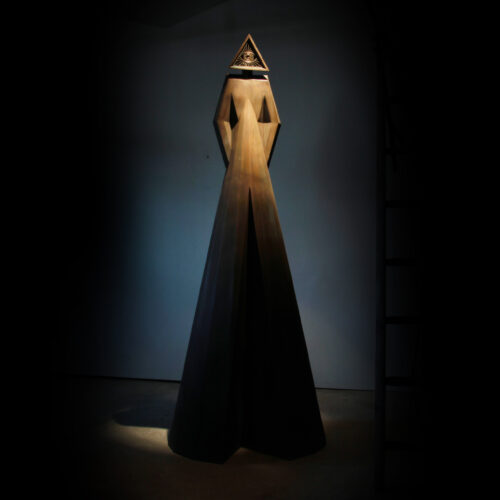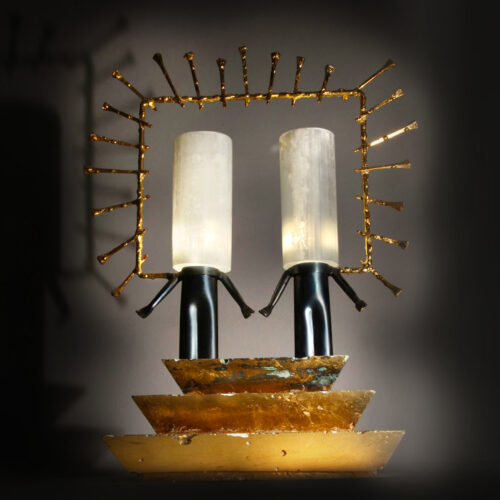From using scrap metal to producing consciousness-driven art, Mark Brazier-Jones discusses his exhibition of shamanic sculptures at Secteur Privé, a new “living spaces” art concept
The notion that art can improve mental well-being is something intuitively understood by designer and artist Mark Brazier-Jones. After four decades of creating art bespoke furniture designs for private clients, films and museums all over the world, Brazier-Jones has created a series of sculptures for the home.

Incorporating crystals and holistic materials into works of beauty, the current body of work, entitled Where Do I Begin, is on show at Secteur Privé, a new London art concept started by art enthusiast, Ayman Daouk, who has crafted a master plan to stage art shows from luxurious private spaces globally.
Disenchanted with the ‘white cube’ gallery experience, where guests stand in brightly-lit locations to view an artists’ work, Secteur Privé take a more integrated, considered approach: their objective is to give their guests a sense of how it would feel to live with the works and offer them more coherent experience of the art.
After entering the luxurious space, be it an opulent living room or salon, guests are handed a cocktail, a glass of good wine and a delicious canape. While there, they can peruse the work in a home (albeit a rather grand) environment. As nobody’s home looks like a gallery, an artists’ work is given a more meaningful context and shows how the pieces might work with the potential buyers existing pieces and furniture.

At Where Do I Begin, Brazier-Jones work takes the lead, with considered curation of the living space fleshed out with supporting works by rising stars in the art world. The works of Talia Gochin, a young Iranian artist making global waves, whose work has featured at The Tate Modern, Art Basel and Frieze feature alongside Marcus Dove, who has recently collaborated with great success with Yinka Shonibare as well as Columbian artist, Mario Vélez.
Mark Brazier-Jones has enjoyed a 40-year career, which started out as a set designer for pop videos in the 1980s, for artists such as David Bowie, Kate Bush, Elton John, Spandau Ballet and Queen. He started a co-founded a ‘Creative Salvage’ collective with Nick Jones, Tom Dixon and later, André Dubriel, putting nights on in empty warehouses, where making furniture out of scrap was part of the visual performance.
The whole scene, he says, came before the DIY culture of rave and was about cutting and pasting, from the flyers put together by Tom Dixon, to the mixing and overall production.
After becoming a successful part of the nocturnal London culture, they would put on several pop-up furniture shops before disbanding, each going their separate way towards making luxury items.
Now Secteur Privé, have afforded Brazier-Jones the chance to put on a show of work that channel his passion and practice. With a new body of work that took seven years to produce, Where Do I Begin is a series of spiritually-inspired sculptures that can help raise the vibration in the home. We catch-up with him on how they work.
You have created manifesting machines. Can you tell us how they work and how people can incorporate the works into their manifestation at home?
I have called the sculptures manifesting machines but it is more accurate to describe them as focal points in meditation. In this way the mind can be brought back to the same point every time. A moment can be taken to connect with the universe and express gratitude.
How did you meet Ayman, the founder of Secteur Prive and what can you tell us about his vision for artists?
I met Ayman the founder of Secteur Privé through his cousin who is an important art collector and international politico in Paris. Ayman had started collecting my furniture many years ago then recently discovered my scientifically spiritual explorations. My research resonated with his on this subject and he suggested we produce this exhibition. I have found working with Ayman and his partner Coco a rare delight. They honour and protect the vision of their artists and I have seen how this extends to the dignity and integrity afforded to their clients.
You’ve made pop videos, furniture, art, sculptures and lighting. How did you decide to incorporate spirituality into your design?
From the beginning of my creative journey, somewhere back in the late 70s, I have worked on some 200 pop videos building scenery. I have made furniture, sculptures, art and lighting. The number of separate unique designs must number over 600. Each new design was been a stepping stone on my personal path of discovery.
I have explored archetypal symbolism gathered from the ancient cultures of the world and I have searched nature for the secret code to beauty. What I have found is that philosophy and religion are blueprints to the manipulation of matter and the code found in nature that describes beauty is mathematical.
How do you select the materials that you use and what is your process? What comes first, the research or the pieces?
The way I work is very instinctual I am constantly re-researching all kinds of subjects and at the same time I am always collecting materials and components. The whole thing very much how it was when I was a child in New Zealand beach combing with my artist father. We would find random things placed them together and project abstract meanings from them.
It is often the way that thoughts and components finally coalesce in a finished artefact many years after their discovery. It is as though my subconscious had picked these ingredients and laid them ready in my future.
What can you explain about the ‘Ding Dings’ and how they work? If I buy one and use it daily, can I manifest my dream life?
One aspect of my explorations has brought me to the work of Japanese scientist Maseru Emote who discovered water has memory. He found if volunteers expressed different emotions to separate samples of water, it would affect the molecular geometry of the ice crystals when the water was frozen. When the subject thought angry and hateful thoughts resulting ice formations took a distorted end unsymmetrical form. When the subject thought lovingly towards the water the results were beautiful six-pointed snowflake formations. These experiments have been confirmed and replicated by scientists all over the world. What it shows is that our consciousness has the ability to manipulate matter.
Tell us more about 528 hertz in the ‘Ding Dings’? Did you know that John Lennon’s “Imagine” was composed in this frequency?
Another avenue of research has brought to my attention the subject of resonant frequencies. Sound plays a role in the arrangement of the quantum field. The work of doctor Leonhard Horowitz describes how there is one situated central frequency to all else that has a special significance to the human form… it is 528 Hz.
In ancient and advanced traditions, priests and healers used the ‘love’ frequency to manifest miracles and produce blessings. This tone is responsible for the structure and repair of human DNA …it is described as the love tone and it corresponds to the heart chakra. John Lennon was aware of this knowledge and wrote Imagine in the frequency.
The sound 528 Hz has a corresponding colour which is also found at the very middle point within the vast electromagnetic spectrum. The green that resides in the absolute centre of the rainbow. The apple green used magically by chlorophyll to turn photons into sugars thus making life possible in this realm.
If water can become structured in accordance with a frequency, then it seems to me 528 Hz would be the tone of choice. And when we consider that our bodies consist of some 90% water the subject becomes a lot more interesting.
Three years ago I spent some time in Varanasi, India participating in various ancient rituals and learning how earth energy and sacred stone technologies are still being used. The devices I exhibit in this show are for the focusing of attention to a singularity.
They provide a reference to which the owner can repeatedly and accurately return. This is where we can find our Higher Self our connection with the creator.
Where Do I Begin will run until 22 January at Secteur Privé www.secteurprive.co
Enquiries create@secteurprive.c

